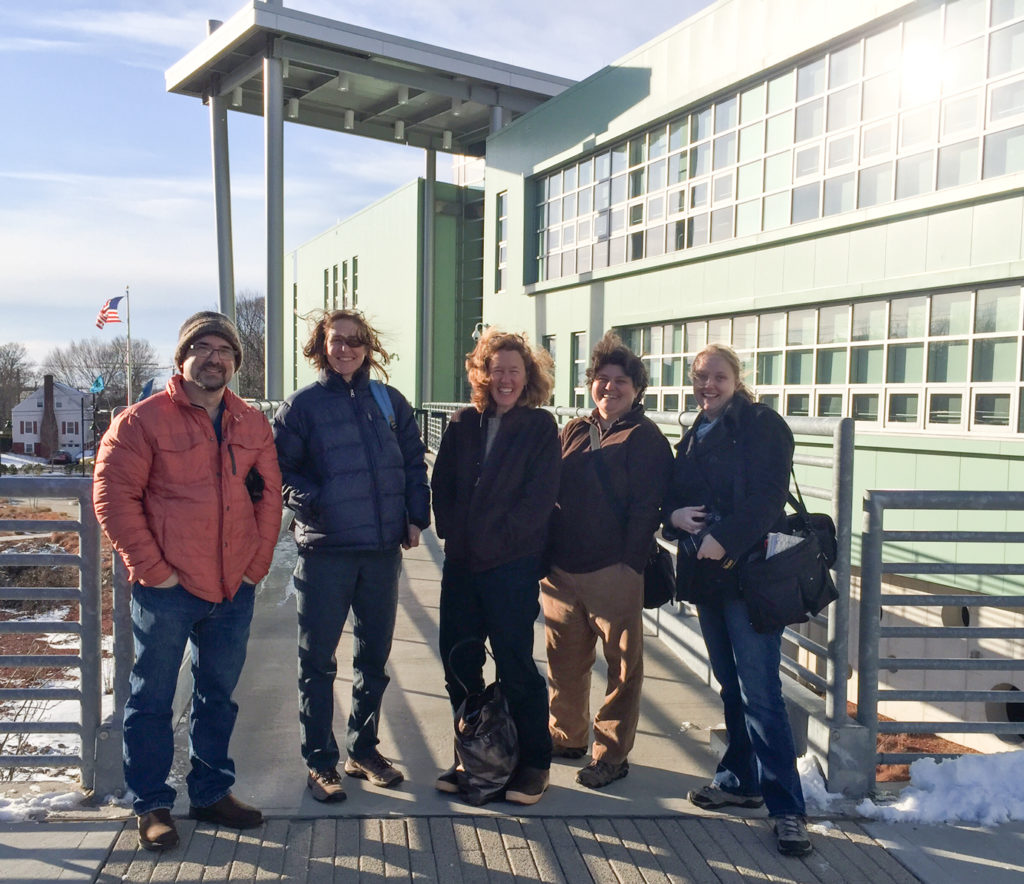Aquaculture in the Gulf of Maine is a good prospect in a number of vital areas, including education. There are increasing opportunities for college-level and adult Mainers to learn about aquaculture, get help starting aquaculture businesses and even earn degrees in related fields.
But what is being offered to high school students in Maine? There are efforts underway at various school and education organizations, but there is currently no state-wide approach to aquaculture education at the high school level. But there is an excellent example of such an approach in another New England state – Connecticut.
To gain insight and inspiration that Maine might use to develop its aquaculture curriculum and facilities, a group of six Maine educators from the St. George School, Hurricane Island Foundation, UMaine, and me (education director at the Island Institute), took a road trip to Connecticut in January to visit three aquaculture high schools.
We learned that there has been a decades long effort underway in Connecticut by aquaculture industry, education, business and political leaders to develop a network of 21st century agriculture centers with a focus on aquaculture, life science and marine trades. They developed innovative marine-based curriculum along with state-of-the-art facilities to enable the state’s students to complete high school and even earn college credits through the study of aquaculture and marine-related fields.

Serge Medvedev, aquaculture teacher at MSMSH, explains a student project to the group
Marine Science Magnet High School
Our first stop was the gleaming Marine Science Magnet High School of Southeastern CT in Groton, a four year-old facility. We saw the different projects and species that students are working on, including a new aquaculture species called barramundi (an Australian fish), which is similar to tilapia. The quality of the facility as well as the passion and commitment of the teachers was striking.
The Sound School
Our next stop was The Sound School In New Haven. We toured the whole facility, which is right on the waterfront and includes a pier, a very helpful asset to their program. The Sound School’s aquaculture facility has a great deal going on, including aquaponics, fin fish, lobsters, shell fish, and ornamentals. Students did a lot of the work in the lab and we saw a number of innovative yet inexpensive ideas, including using Tupperware plastic containers for baby lobster apartments.

Aquaculture instructor Ned Flanagan shows us ‘baby lobster apartments’
Bridgeport Regional Aquaculture Science and Technology Education Center
The third school we visited was BRASTEC (Bridgeport Regional Aquaculture Science and Technology Education Center). We learned more about the history of the magnet school movement in Connecticut and about the efforts of faculty from UConn, the CT legislature, NOAA and a number of international entities to create BRASTEC, which is the largest and most well known of the aquaculture high schools in Connecticut. We took a thorough tour of this incredible facility and met many staff members as well as the school’s advisory council who were having their monthly meeting.

Overhead view of the aquaculture lab at BRASTEC
An important part of the visit was hearing from co-founders Dr. Charles Yarish and John Curtis about the school’s philosophy. They focus on real-world certifications with the goal of preparing each student to be successful either in the workplace (with an emphasis on the shipping industry) or in post-secondary education. They pointed out the failure of traditional high schools to do this and the importance for BRASTEC (and schools like it) to be flexible and change to meet the needs of industry and higher education.
Their approach is project-based, themed-instruction: science and technology education with an emphasis on problem-solving, creativity and innovation. The ‘vocational’ training or workforce development aspect is de-emphasized but they do use real world applications as much as possible and incorporate industry licensure and credentials, such as Serve Safe, HACCP and Coast Guard licenses. They shared a number of inspiring stories about students who have become very successful in fields other than aquaculture as a result of the education the received – and also mentioned that a number of the school’s staff were former students.


BRASTEC instructors often come from marine industries, such as Kenny Killbrook, who was a lobster fisherman turned teacher, He described having a good catch in 1999 and then essentially nothing from 2000 on.
Maya Sushi
One aquaculture-related highlight of the trip was dinner at a New Haven sushi restaurant recommended by Dr. Yarish called Maya Sushi. This innovative restaurant features invasive species and other animals and ingredients not typically found on the menu. Our group was pretty adventurous and tried a number of unlikely, but delicious dishes.

Jellyfish sushi, surprisingly chewy, almost crunchy

Crab cake with baby fried green crab garnish
This trip provided a glimpse at the innovative ways a coastal state can provide a high quality, relevant and practical education to its high school students. As interest in Maine aquaculture increases and promising opportunities for education/workforce development, economic diversification and environmental sustainability are developed, our state would do well to incorporate these topics into a comprehensive aquaculture curriculum and network of facilities, inspired by Connecticut’s aquaculture high school education model.


